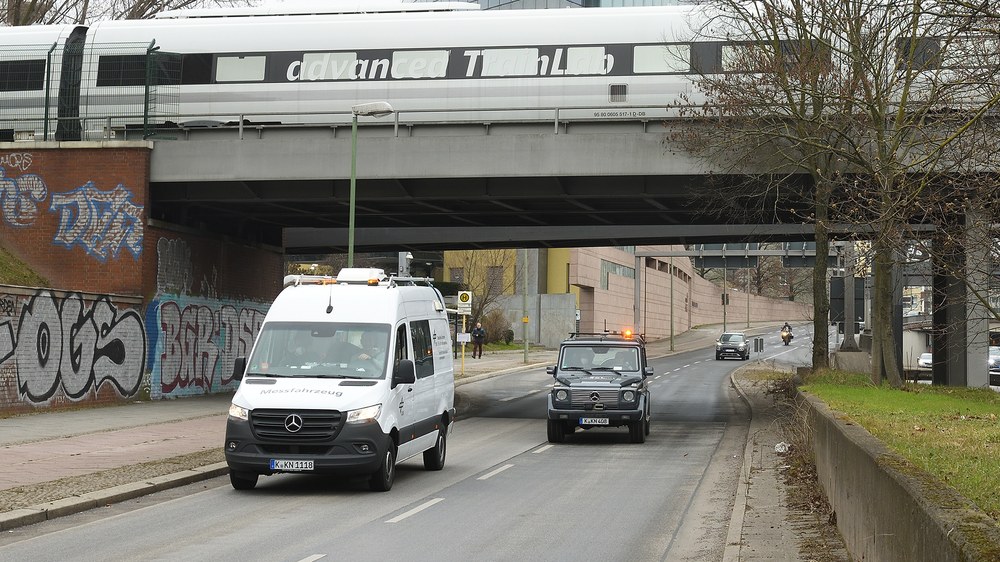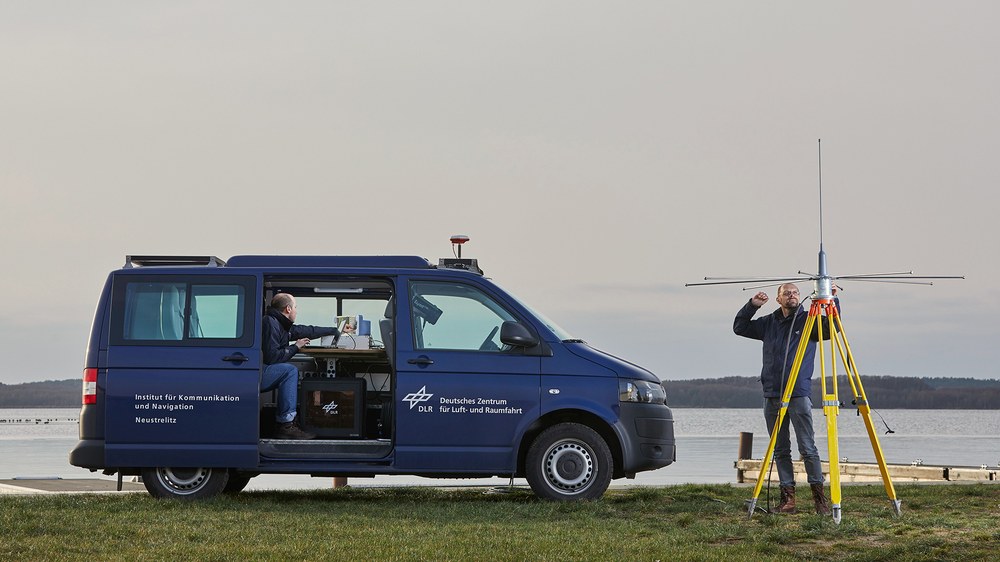Vehicles, aircraft and ships
The Institute regularly uses its own vehicles, the DLR aircraft fleet as well as ships and trains for measurement and demonstration campaigns in the real environment.
Vehicles
The so-called SoL (safety-of-life) vehicle is used for wave propagation measurements (including vehicle-vehicle and vehicle-train), for demonstrating vehicle-vehicle communication, for "cooperative situational awareness" in road traffic and for preparing and supporting numerous measurement campaigns for traffic, aerospace and space applications. For this purpose, the SoL vehicle is equipped with computing units, communication hardware and numerous sensors. Accurate self-localisation of the vehicle is achieved by integrating precise GNSS receivers and inertial measurement units. A radar and a laser scanner are used to detect the surroundings.
The measurement vehicle in Neustrelitz serves to support measurement campaigns in the nautical field. In addition to its suitability as a mobile reference station, it also offers the possibility of carrying out land-based tests and verifications of components and systems from the areas of multi-sensor technology and traffic situation detection.
Another vehicle is part of the transportable optical ground station.
Aircraft
DLR operates the largest fleet of civil research aircraft and helicopters in Europe at its Braunschweig and Oberpfaffenhofen sites. The Institute uses the aircraft in a variety of ways for measurements, experiments and technology demonstrations. In the reporting period, for example, test flights were carried out on the topics of digital aeronautical radio, aeronautical navigation solutions, landing and approach procedures, acquisition of GALILEO navigation signals, optical communication and quantum key transmission. The aircraft used were primarily Do 228s and the ATTAS, which has since been decommissioned. In individual cases, the FALCON and the Airbus A320 (ATRA) are also used.
In addition, a digital communication link for the ATRA was developed and scaffolded and the permanent installation of a GNSS receiver was realised.
Ships
In order to be able to test navigation and communication components developed at the Institute under real conditions in the maritime sector as well as in the field of inland navigation, there are various partnerships and cooperations with authorities and companies. For example, the installation of a complete PNT data processing unit, including corresponding sensors such as GNSS receivers, IMU, gyro and speed log on the ship "Baltic Diver II" of the Rostock-based company Baltic Taucher, enabled the Institute to carry out a whole series of short-term measurement campaigns in the Baltic Sea in recent years. Furthermore, measuring equipment for long-term measurements has been installed on the ferry Mecklenburg-Vorpommern of the shipping company StenaLine, which operates in the Baltic Sea, since 2015. As part of the cooperation with the Maritime University of Szczecin, joint measurement campaigns are repeatedly carried out using the ship "Navigator XXI". In the inland navigation sector, cooperation with the Federal Waterways and Shipping Administration has enabled us to test our methods on inland vessels such as the "MS Bingen" for years.
Within the framework of measurements on the propagation of radio signals for new maritime applications, the Institute used various other ships: On the Baltic Sea, the maritime motor vessel "Rosenort" of the Federal Waterways and Shipping Administration (operated by the Stralsund Waterways and Shipping Office), on the North Sea, the sea rescue cruiser "Hermann Marwede" of the German Maritime Search and Rescue Service (DGzRS) and the multi-purpose vessel "Neuwerk" of the Federal Waterways and Shipping Administration (operated by the Cuxhaven Waterways and Shipping Office) stationed on Helgoland.
Trains
The Institute used numerous train journeys in regular operation with the following railway companies for measurements to localise trains (using inertial measurement systems and magnetic field sensors): Bayerische Oberlandbahn GmbH (BOB), Bayerische Regiobahn GmbH (BRB) and Harzer Schmalspurbahnen GmbH (HSB). Special measuring boxes were developed for the journeys, which could be quickly attached to the train and recorded the sensor data without the need for employees of the institute to travel along.
Furthermore, as part of the development of a wireless communication system between wagons, test runs were carried out on the track system of the Institute for Rail Vehicles at RWTH Aachen University. To record the transmission properties in train-to-train communication, the institute organised an extensive measurement campaign with two high-speed trains of Trenitalia.



